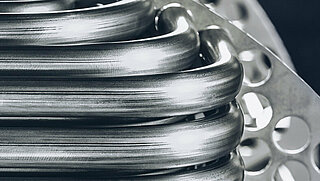
FUNKE Heat Exchangers Innovative SME with a passion for technology
Whether it is shell-and-tube heat exchangers, plate heat exchangers, air-cooled heat exchanger or electric oil pre-heaters, FUNKE has thermodynamic solutions for almost any application in all kinds of industries. In addition to heat exchangers produced with a modular system design, we produce heat exchangers according to customer specifications in compliance with international standards and regulations.
Heat exchangers for industrial applications
Heat exchangers are part of our day-to-day life. They are used wherever liquids or gases need to be heated or cooled. FUNKE specialises in heat exchangers for industrial applications. Accordingly, FUNKE heat exchangers are used in industries such as mechanical engineering, chemical process engineering, shipbuilding and compressor technology for oil cooling. In the chemical and pharmaceutical industries, they are used to thermally treat products or manage the temperature of process water. In recent years, applications in energy use and new energies have become increasingly important. The efficient use of energy and energy conservation is an important area in companies today.
FUNKE worldwide
We are on hand to help you worldwide. Find your nearest FUNKE location or sales and service partner quickly and easily.